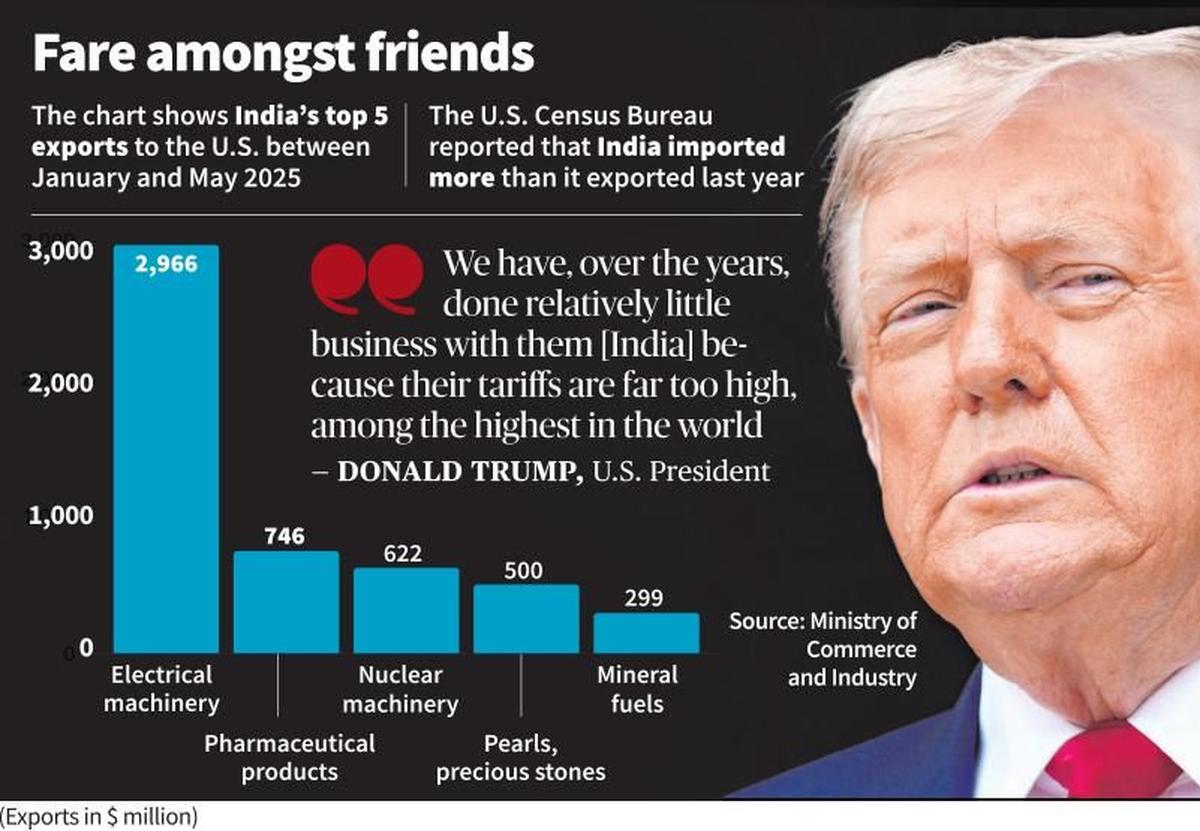Context:
On July 31, 2025, US President Donald Trump announced a 25% tariff on Indian imports, along with potential penalties for defence and energy purchases from Russia, significantly impacting the trajectory of India-US trade negotiations.
What is the India-US Trade Agreement?
The India-US Trade Agreement refers to a proposed Bilateral Trade Agreement (BTA) that both countries agreed to pursue during Prime Minister Modi’s visit to Washington in February 2025.
· This agreement is part of the broader US-India COMPACT, with the goal of doubling bilateral trade to $500 billion by 2030 and finalizing initial trade deals by Fall 2025. However, the talks face challenges due to earlier 25% tariffs imposed by former US President Donald Trump.
· The BTA must comply with World Trade Organization (WTO) rules, as both nations are WTO members. Most international trade law is based on the General Agreement on Tariffs and Trade (GATT).
· One key principle under WTO law is Most Favoured Nation (MFN), which prevents countries from discriminating between trading partners.
· Although the BTA is not officially labeled as a Free Trade Agreement (FTA), if it functions like one, it must meet specific legal requirements.
· Under Article XXIV.8(b) of GATT, FTAs must remove trade barriers on “substantially all the trade” between member countries. In addition, the agreement must be notified to the WTO for transparency and compliance.
Trade Issues between India and the US over Tariffs:
- One of the main trade issues between India and the United States is India’s high tariff structure, which the US believes makes trade unfair and expensive. On average, India charges a 17% tariff on imported goods, while the US average is much lower at 3.3%.
- The disparity is even more pronounced in agricultural tariffs, where India imposes a substantial 39% tariff, compared to the US's 5% tariff on agricultural products.
- This difference in tariff structures has contributed to the growing trade deficit between the two countries, with the US goods trade deficit with India reaching $45.7 billion in 2024, a 5.1% increase from the previous year.
Geopolitics over Economics:
Trump's recent trade announcements have highlighted a shift in US-India relations, with geopolitics taking center stage over economic considerations. The US president has accused India of being one of Russia's largest energy buyers, alongside China, and announced a US-Pakistan oil deal, seemingly to pressure India into compliance. By linking trade talks to the Ukraine war and India's Russia ties, the US appears to be reshaping global trade alliances through pressure rather than negotiation.
Challenges in India-US Trade Negotiation:
- Tariff reduction mechanisms, particularly on agriculture and dairy
- Non-tariff barriers, like regulatory standards and technical norms
- Rules of origin, especially in complex supply chains involving China
- Anti-dumping and safeguard duties, which the US wants relaxed
- India’s refusal to offer zero-duty access like it did for the UK or UAE
India is unlikely to match EU-style investment promises or agree to US-style comprehensive digital trade clauses without careful cost-benefit analysis.
India’s Strategic Choices
- Diversify exports and reduce overdependence on US markets
- Deepen FTAs with other large economies (e.g., EU, African Union, Latin America)
- Strengthen domestic competitiveness through quality and pricing reforms
- Maintain a firm but flexible stance—protecting sovereignty while securing trade gains
Conclusion:
The India-US trade negotiation has transformed from a bilateral economic exercise to a test of geopolitical alignment and national resilience. Trump’s tariff imposition and Russia-related penalties are not just trade tools—they are levers of foreign policy.







